
Amazing things, apples. Attributed with numerous health benefits (verging on the miraculous, thanks to the old idiom “an apple a day . . .”), they've come a long way from their beginnings on the Tree of Life and that scandal in the Garden. No blame. Now they are at the heart of school lunch boxes, fruit salads, tarts, pies and all manner of sauces, jellies and chutneys.
I can see why Eve was tempted: their piquant, sweet taste and satisfying crunch make them so enjoyable to eat. But if her resistance was broken by a single piece of fruit, the mind boggles as to how she'd have fared in the West Country (the largely rural area covering the South West of England), which is groaning with apples and pears at this time of year.
At the suggestion of a bon vivant French friend, we travelled from London to the beautiful Forest of Dean (near Gloucester and north of Bristol) to experience just one of the many ways to make use of the apple glut: cider.
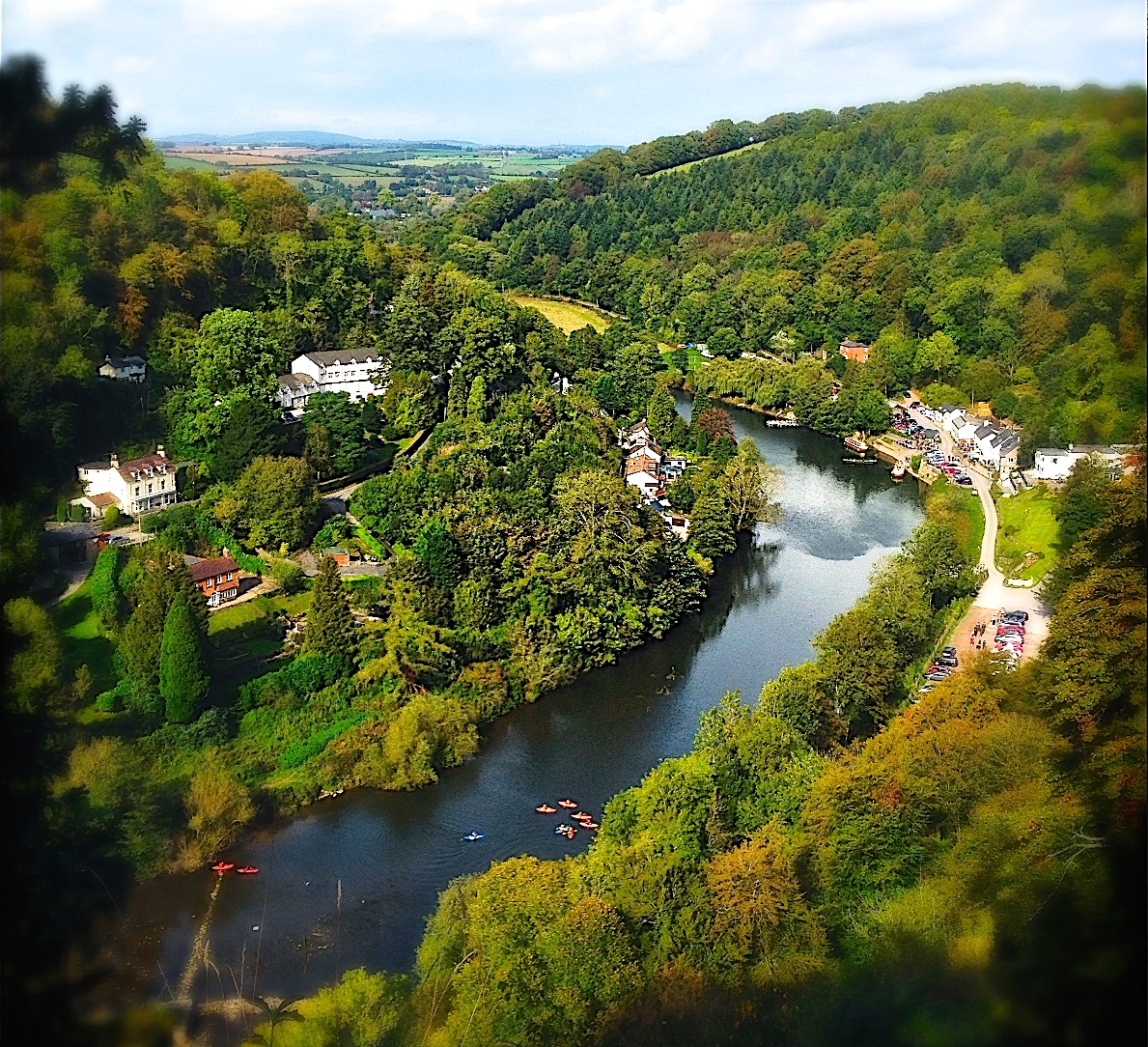
Symonds Yat, a village in the Forest of Dean that straddles the River Wye (seen here) and the borders of the English counties of Herefordshire and Gloucestershire. “Yat" is an old word for a gate or pass.
I should explain that the cider we have in the UK is rather different to its North American counterpart. For a start, it's alcoholic: in some cases, as much as 8.5%, which is pretty feisty, but nothing compared to some hard-hitting 12% stuff in continental Europe! It can be sparkling or still, cloudy or clear, ranging in colour from delicately amber-hued to a rich, deep rust. There are mass-produced ciders on the market, usually packed full of added sugar and additives, but we were only interested in the artisanal drink — made with love and care, a great deal of back-breaking work and no small amount of skill.
No strangers to a bit of home cider-making ourselves, we wanted to see how the professionals do it. We headed off to Severn Cider, an award-winning business that makes cider and perry (pear cider) from carefully-selected heritage fruits. Founded by Nick Bull, it’s a real family affair, with his son Tom making the cider and his wife, May, cooking lunches and hosting guests staying at the beautiful farmhouse that has been in the family since Nick’s father bought it for £3,300 in 1956.
They are extremely committed to the conservation of heritage apples and pears grown organically in local orchards — including one propagated from the last known surviving Box Kernel tree.
Their ciders and perrys have won numerous awards and are stocked in smart London establishments, including designers shops and art galleries, but the farm itself is truly and unashamedly authentic: mud, tractors and all the necessary machinery needed for the cider process, from harvest to bottling.
Nick explained that they are extremely committed to the conservation of heritage apples and pears; all the fruit they use has been grown organically in local orchards growing old, traditional varieties, including an orchard propagated from the last known surviving Box Kernel tree. The fruit trees are harvested at different times, ensuring that each variety is picked by hand when it’s perfectly ripe before being hand-sorted and washed, and made ready for milling and processing.
As we sipped on our first drink of the day, a deliciously warming mulled cider, we watched one of the workers, Al Day, hard at work shovelling scratted apples (shredded to make them easier to break down) into a wooden cider press. It looked like back-breaking work, but it was mesmerising to watch the pulp being laid between each wooden palette in the press and the juices oozing out. Apparently, the remaining pulp is then used to feed the farm’s pigs and the resulting meat is packed full of apple-y deliciousness as a result. Meanwhile, the juice is fermented and then matured in oak casts until ready for bottling.
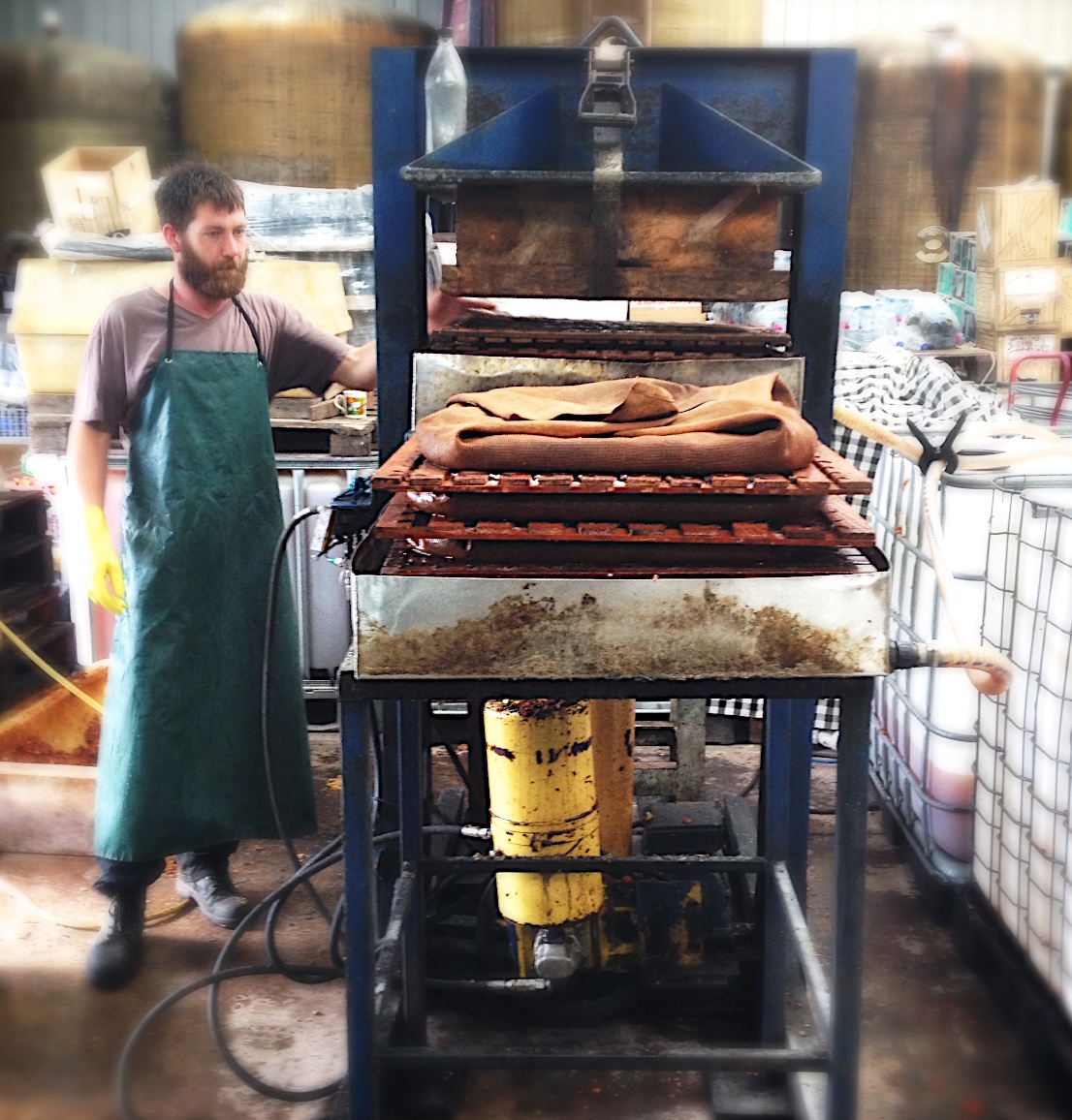
Al Day, a worker at Severn Cider, running the cider press.
MULLED CIDER
INGREDIENTS (all quantities are rather approximate; feel free to make it spicier or sweeter, as you wish)
2 litres (4 pints) of good quality traditional cider
5 tablespoons sugar
2 x cinnamon sticks
½ teaspoon ground cinnamon
6 x cloves
3 x star anise
Small piece of fresh ginger (about 2.5cm or 1” long)
½ teaspoon ground ginger
¼ nutmeg, grated finely
METHOD
Heat all the ingredients in a large pan, bring to the boil and then simmer for a few minutes — this infuses the cider with the fragrance of the spices, concentrates the flavour and pasteurises the cider by killing off the wild yeast.
Strain the liquid through a fine mesh sieve or a sieve or colander lined with a clean muslin cloth. The mulled cider can then be stored in sterilised bottles for a year.
Gently heat before serving.
After about 10 “tots” of different ciders and perry, we made our way (a little unsteadily) through to lunch. As I suspected, cider makes the most wonderful partner to a ploughman’s lunch, with four local cheeses, homemade bread, salad from May and Nick’s garden and ham cooked in cider (but of course). My favourite match for the cheese was a medium-sweet sparkling cider, but it’s deeply personal and others preferred a much drier drink with more pronounced tannins.
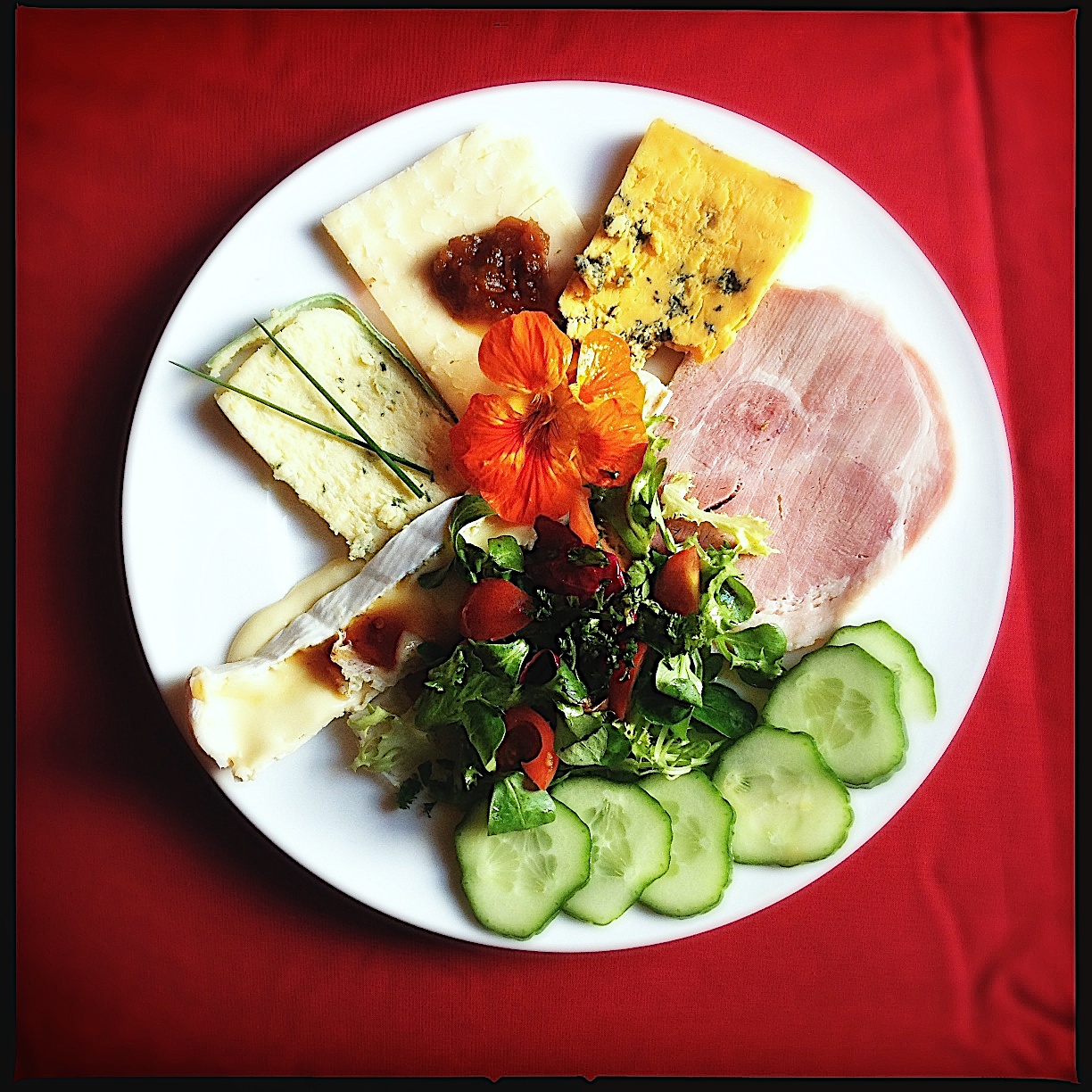
A PERFECT PLOUGHMAN'S LUNCH
The key here is the quality of the components - supermarket bread served with sweaty, plastic cheese, synthetic ham and mass-produced chutney is NOT going to make a good lunch in any way, so take a trip to a lovely farmers’ market, farm shop or artisanal supplier to find some wonderful local products. Serve on individual plates or a big, communal platter with a steady flow of cider.
INGREDIENTS
Selection of local cheeses: mature Double Gloucester cheese with chives, organic cow's Camembert (so ripe it was almost running off the plate — my idea of heaven!), an organic Cheddar (made in Cheddar, Somerset, its birthplace; hence the capital C) and a Shropshire Blue.
Chutney
Ham (ours had been slow-cooked in the cider)
Salad (rocket, sorrel, nasturtium, marigold, mint, tarragon, parsley, cucumber and tomatoes all came from the garden)
Homemade breads and butter
We were lucky enough to coincide our visit with a local food festival on the Sunday, which attracted artisan producers from all around the region. The sun shone brightly and, anticipating our hearty walk in the forest later, we treated ourselves to more lovely cider and a bread bun filled with succulent shredded pork and some of the best apple sauce I’ve ever tasted. The result was utterly mouth-watering - it’s hard to recreate a full-on hog roast when cooking for just a few people at home, but slow-cooking a shoulder of pork for a small crowd is simple and completely delicious.
Making apple sauce can be as simple as peeling and coring the apples then slow-cooking them in a saucepan over a very low heat until they break down into a mush (some people add sugar or butter, but if the apples are sweet, all you need is a little water to help the process and ensure the apples don’t burn in the pan). Zuni Café in San Francisco does a wonderful roasted apple sauce recipe, which I will share with you here.
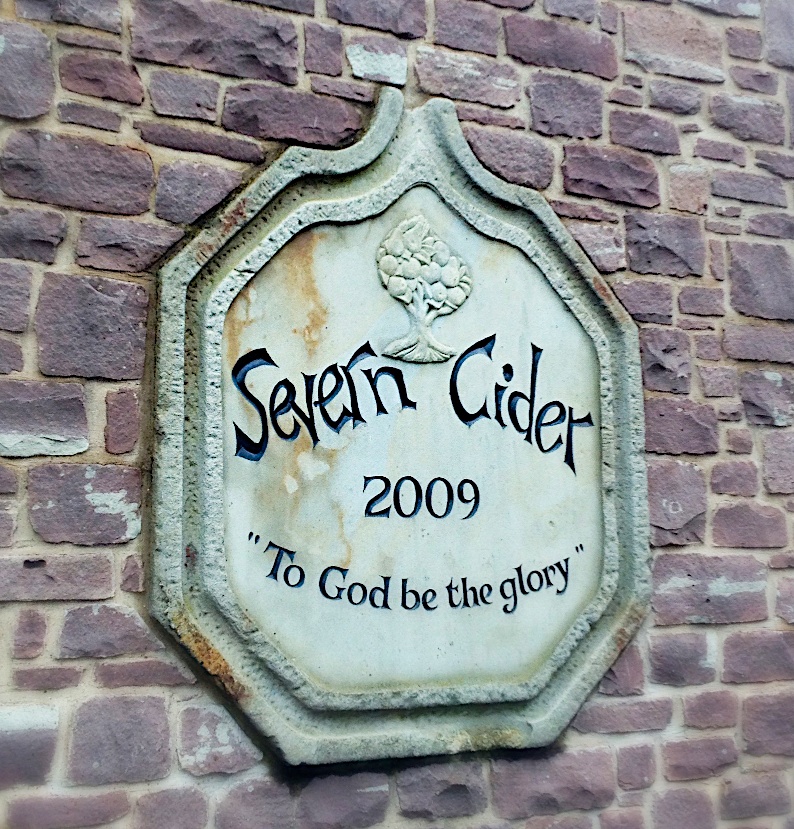
SLOW-ROAST PORK SHOULDER WITH ROASTED APPLE SAUCE
INGREDIENTS
FOR THE PORK:
A shoulder of pork, skin on
Coarse sea salt or kosher salt
1 tablespoon fennel seeds
6 cloves garlic, peeled and crushed
1 tablespoon fresh thyme leaves, or ½ tablespoon dried thyme leaves
FOR THE APPLE SAUCE (recipe from “The Zuni Café Cookbook” by Judy Rodgers; makes about 3 cups):
1.5 to 1.8 kilos / 3½ to 4 pounds apples
Pinch of salt
Up to 2 teaspoons sugar, as needed
About 2 tablespoons unsalted butter
A splash of cider vinegar, as needed
METHOD
For the pork: start the process two days before you’re serving the pork for lunch, or the morning of the day before you’re having it for dinner.
Using a pestle and mortar, blitz together the fennel seeds, garlic and thyme.
Score the skin with a small, very sharp knife, rub in the salt, then rub in the mix of fennel, garlic and thyme. Marinade for about a day.
Set your oven to its hottest setting and cook the pork for 20-30 minutes until it’s brown and crispy, then turn the oven to its lowest setting and continue to cook the pork for about 10 to 12 hours, until it’s meltingly tender and falling apart.
While the pork is cooking, make your apple sauce: preheat the oven to 190℃ / 375℉ (or 170℃ / 340℉ fan oven).
Peel, core and quarter the apples. Toss with a little salt and, unless they are very sweet, a bit of sugar to taste. If they are tart enough to make you squint, add the full measure of sugar. Spread in a shallow baking dish that crowds the apples in a single layer. Drape with slivers of butter, cover tightly, and bake until the apples start to soften, 15 to 30 minutes, depending on your apples.
Uncover, raise the heat to 260℃ / 500℉ (240℃ / 465℉ fan oven), and return the pan to the oven. Leave the apples to dry out and colour slightly, about 10 minutes.
When the tips of the apples have become golden and the fruit is tender, scrape them into a bowl and stir into a chunky “mash”. Season with salt and sugar to taste, then consider a splash of apple cider vinegar to brighten the flavour (try a drop on a spoon to see if you like it).
This roasted apple sauce also makes a fabulous filling for my almond crumble. Blackberries are also in season now, so I stirred a few through the apple sauce as the two fruits go together beautifully.
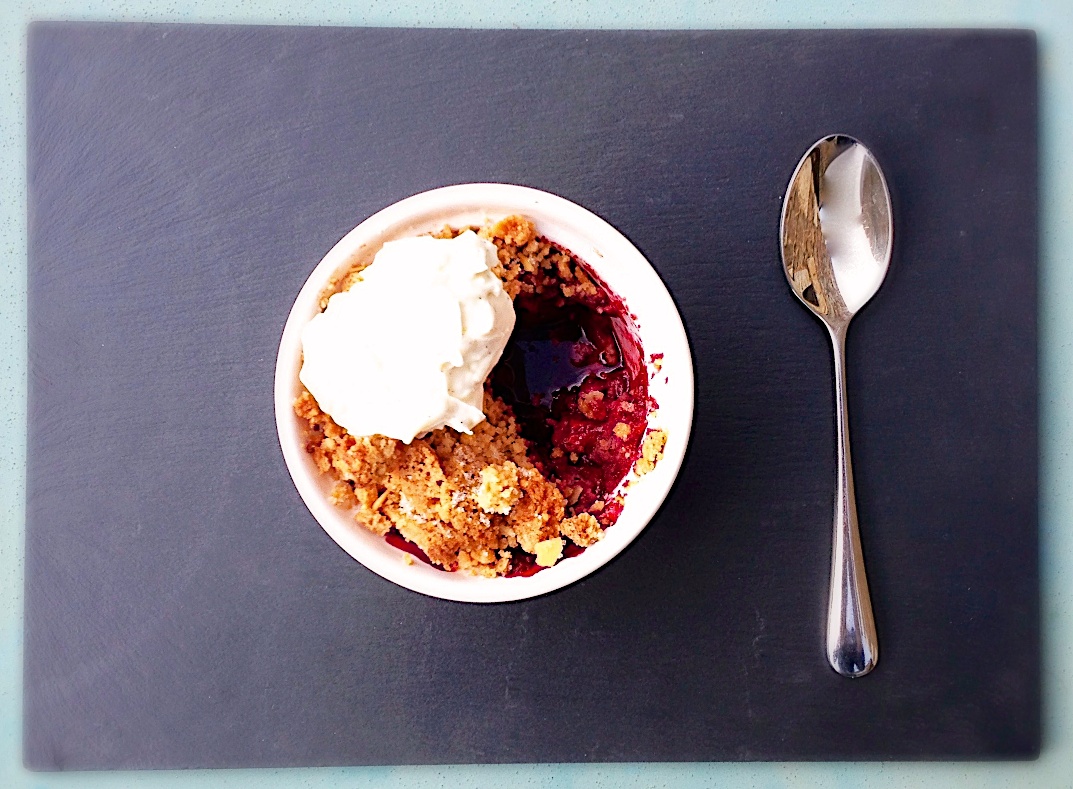
NUTTY APPLE CRUMBLE
INGREDIENTS
140g / 5oz plain flour
50g / 1¾ oz granulated sugar plus 1 tablespoon extra
50g / 1¾ oz light or dark brown sugar
⅛ teaspoon salt
2 teaspoons vanilla extract
85g / 3oz unsalted butter, softened and cut into 6 pieces
55g / 2oz flaked/sliced almonds
METHOD
Heat oven to 190℃ / 375℉ (170℃ / 340℉ fan oven).
Combine flour, sugars and salt in magimix bowl — drizzle vanilla over the top. Pulse in 5 x 1-second blasts, add butter and halve the almonds. Process until the mix clumps together (approximately 30 seconds), scraping sides halfway through. Sprinkle over remaining almonds and combine with two quick pulses. Spread in a thin layer on parchment-lined baking sheet and bake in middle of oven until chunks are lightly browned and firm (about 18-22 minutes). You can keep the cooled topping in a jar or tupperware for a couple of weeks.
To assemble and bake: sprinkle the topping over the peaches in the dish(es) and sprinkle over the remaining teaspoon of sugar. Place in the lower third of the oven at 200℃ / 390℉ (180℃ / 355℉ fan oven) until well browned and the fruit is bubbling at the edges (20-35 minutes, depending on the size of the dish(es) — one big, or individual smaller ones). Cool the crumble on a wire rack until warm (at least 15 minutes) and serve.
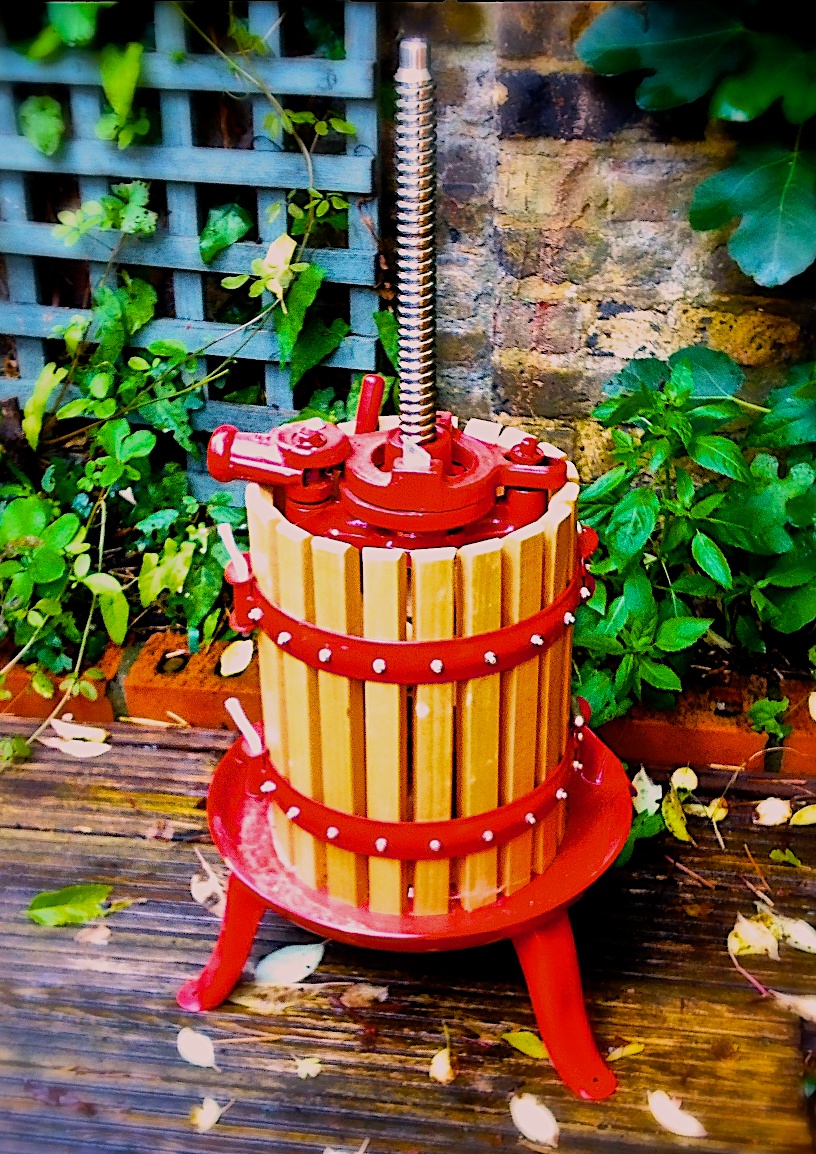
Laura's cider press at home.
This tastes great with vanilla ice cream, or a mix of half crème fraîche and half mascarpone — with the seeds from one vanilla pod and some icing sugar added to taste. TO MAKE IN ADVANCE, scoop into a sieve seated over a bowl, cover with clingfilm and leave in the fridge, which drains off the excess water.
For more information on cider, the Bull family and their farmhouse, visit www.severncider.com
On our visit to Forest Dean, we also visited the annual Forest Showcase Food & Drink Festival www.forestshowcase.org

LAURA POPE works as a private chef to clients in the UK and abroad. She has also cooked in some very wonderful establishments worldwide - from a boutique hotel in southwest France to the restaurants Chez Panisse in California and Ottolenghi in London. She is also a blogger, teaches classes on gluten-free cooking, and creates recipe apps.
See Laura’s website and Facebook page.
PHOTOS by the author.

Add new comment